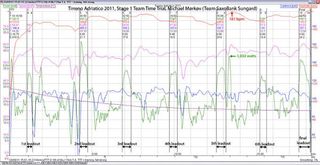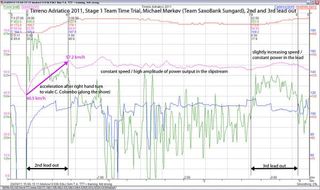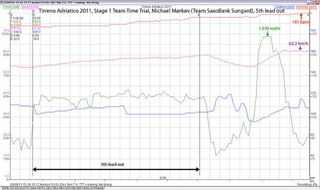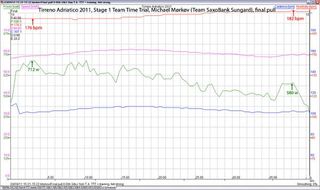Michael Mørkøv's SRM data from Tirreno-Adriatico TTT
Saxo Bank Sungard trainer Giuseppe Toni analyses Dane's performance






Have you ever wondered what kind of power a world-class professional generates in a team time trial? The 2011 edition of Tirreno-Adriatico opened on March 9 with such an event, a 16.8km team time trial in Marina di Carrara.
Included in the eight-man Saxo Bank Sungard line-up was Denmark's Michael Mørkøv: a former world champion on the track in the team pursuit and Madison disciplines, a formidable presence on the winter Six Days circuit and a multi-time national champion on both road and track.
Cyclingnews has exclusive SRM PowerMeter data from Mørkøv's ride with expert analysis by Saxo Bank Sungard's team trainer Giuseppi Toni.
SRM data - Tirreno-Adriatico team time trial stage
By Giuseppe Toni - Team Trainer, Saxo Bank Sungard, in cooperation with SRM
Rider: Michael Mørkøv, Denmark
Age: 25
Weight: 69kg
Team: Saxo Bank Sungard
Race Time: 18:19
Average speed: 54.95 km/h
Average power: 381 watts
Average cadence: 106 rpm
Average heart rate: 172 bpm
Lead-out position: 7 times
Average length of lead-out: 28 seconds
Michael’s previous test data:
Performance test on the track at 50 km/h requires 372 w
Threshold values 70-380 w (5.4 w/kg)
Get The Leadout Newsletter
The latest race content, interviews, features, reviews and expert buying guides, direct to your inbox!
Introduction

"Michael came straight to the road from his track season and was able to hold onto his good condition. He had several top results on the track, such as a victory in the Copenhagen Six Days.
Tirreno-Adriatico started with a team time trial on the promenade of Marina di Massa. The atmosphere was awesome with perfect conditions for the riders - mild temperatures and moderate side winds.
The first part of the course took place downtown with bends and roundabouts but in the second much longer section the pros were able to find their perfect rhythm with regular lead-outs in intensity and duration.
The SRM data highlights the time trial sections where Michael found himself in the lead with times ranging from 18 seconds to 39 seconds and intensity far above 500 watts. In particular, the second section of 30 seconds indicates a 690 watt (10 w/kg) average and maximum of 881 watts.
Michael is a rider with good motor skills due to his track experience. He was able to ride an average cadence of 106 rpm for the whole time trial.

During the second lead-out, his heart rate started at 166 bpm but increased to 175-176 bpm by the end. From that point on his heart rate never fell below 170 bpm.

Also amazing was his effort after his 5th lead out (35 seconds, 589 watts average) when he had to sprint to get back into the slipstream of the team: 1,033 watts maximum pushed his heart rate up to 181 bpm. An all-out sprint effort during a time trial! In the final of a flat stage sprinters reach about 1,300 to 1,600 watts depending on their body weight.
This section also shows that Michael is a very valuable rider in a team time trial. In the lead, he constantly increased the speed from 53.8 to 59.9 km/h. But this section also shows the limitation of heart rate as a predictor of intensity. At the end of the lead-out his heart rate still increased while his power dropped. After the highly anaerobic effort in the lead, oxygen had to be transported to the muscle so the heart rate remained close to maximum. A heart rate reaction to changing efforts always happens with a certain delay - very obvious if you take a look at the whole time trial and the undulation of the heart rate (red line) with a small amplitude - especially compared to the green power line.
Both parameters - power and heart rate have certain values to evaluate muscular efforts - in training and competition. Combined with cadence and speed this gives the big picture of the individual performance capacity.

Luckily for the team, he was able to recover again for two more lead-outs. The final pull, especially, shows his fabulous time trial skills - 40 seconds averaging 597 watts (8.7 w/kg) with a heart rate maximum of 181 bpm, helping his team to finish fourth at 11 seconds behind Team Rabobank."
Most Popular


